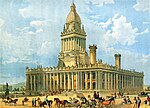Quebecs Hotel, Leeds
Grade II listed buildings in LeedsGrade II listed hotelsHotels in Leeds

Quebecs is a Grade II listed 4-star hotel with 44 rooms located on Quebec Street in Leeds, West Yorkshire, England. Built in 1891, the building has two-storey-high stained glass windows which display the coats of arms of the principal towns of Yorkshire. Previously the building was used as the headquarters of the Leeds & County Liberal Club. The building underwent a £6 million renovation when it was acquired by The Eton Collection in 2000.
Excerpt from the Wikipedia article Quebecs Hotel, Leeds (License: CC BY-SA 3.0, Authors, Images).Quebecs Hotel, Leeds
Little King Street, Leeds Holbeck Urban Village
Geographical coordinates (GPS) Address Nearby Places Show on map
Geographical coordinates (GPS)
| Latitude | Longitude |
|---|---|
| N 53.796711 ° | E -1.549205 ° |
Address
Quebecs Hotel
Little King Street 9
LS1 2HA Leeds, Holbeck Urban Village
England, United Kingdom
Open on Google Maps











